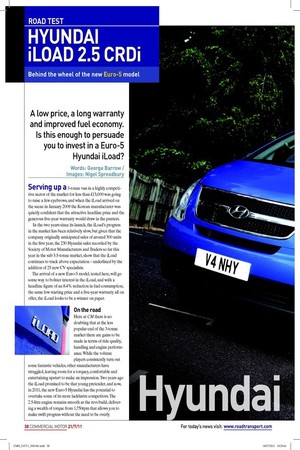HYUNDAI iLOAD 2.5 CRDi
Page 33

Page 35

If you've noticed an error in this article please click here to report it so we can fix it.
Behind the wheel of the new Euro-5 model
A low price, a long warranty and improved fuel economy. Is this enough to persuade you to invest in a Euro-5 Hyundai iLoad?
Words: George Barrow / Images: Nigel Spreadbury
Serving up a 3-tonne van in a highly competitive sector of the market for less than £13,000 was going to raise a few eyebrows, and when the iLoad arrived on the scene in January 2009 the Korean manufacturer was quietly conident that the attractive headline price and the generous ive-year warranty would draw in the punters.
In the two years since its launch, the iLoad’s progress in the market has been relatively slow, but given that the company originally anticipated sales of around 300 units in the irst year, the 230 Hyundai sales recorded by the Society of Motor Manufacturers and Traders so far this year in the sub 3.5-tonne market, show that the iLoad continues to track above expectation – underlined by the addition of 25 new CV specialists.
The arrival of a new Euro-5 model, tested here, will go some way to bolster interest in the iLoad, and with a headline igure of an 8.4% reduction in fuel consumption, the same low starting price and a ive-year warranty all on offer, the iLoad looks to be a winner on paper.
On the road
Here at CM there is no doubting that at the less popular end of the 3-tonne market there are gains to be made in terms of ride quality, handling and engine performance. While the volume players consistently turn out some fantastic vehicles, other manufacturers have struggled, leaving room for a torquey, comfortable and entertaining upstart to make an impression. Two years ago the iLoad promised to be that young pretender, and now, in 2011, the new Euro-5 Hyundai has the potential to overtake some of its more lacklustre competitors. The 2.5-litre engine remains smooth as the revs build, delivering a wealth of torque from 1,750rpm that allows you to make swift progress without the need to be overly aggressive with the throttle. Even with a full load, we were able to surge through the gears, utilising the wellpositioned but slightly notchy ive-speed box, showing a capable performance on motorway, country and city roads.
The ride quality too is superior to many of its rivals, but at the cost of some feedback to the driver, as the soft (relatively speaking) suspension makes the iLoad loat through bends rather than gripping keenly. It’s a minor detraction from an otherwise impressive performance.
Productivity
We’ve spoken about the fuel-saving claims of new Euro-5 models, and to date, few have really hit the mark. The Mercedes-Benz Vito 110 we tested in January (CM 6 January) recorded a commendable 36.5mpg laden and 40.9mpg unladen, and if the iLoad is to cut the mustard among the 3.0-tonne elite it really needs to match or better that result. Our previous test of the Euro-4 iLoad (CM 12 February 2009) saw the Korean panel van record 35.3mpg on the laden voyage and 37.3mpg on the unladen trip. Our test of the new Euro-5 model saw both those igures beaten, albeit not by much. While the 38mpg recorded for our unladen test and 35.4mpg fully loaded is still a great result, it’s not the 8.4% improvement we might have expected. The 1,062kg payload and 5.4m3 load volume enable Hyundai’s MPV-derived panel van – the passenger car version is sold as the i800 – to compete on capacity, but the problems with access remain. The twin side doors provide useful access to both sides of the 1,620mm loadspace width, however the doors don’t completely clear the aperture, hindering access. Combine this with the sloping bulkhead, and the iLoad is less suitable for those needing constant access to their load space.
Cab comfort
Up front the passenger car inluence has beneited the overall comfort of the Hyundai van. It’s no Rolls Royce, but unlike many CVs, there is plenty of adjustment front to back in the seat, and that sloping bulkhead allows a slightly more laid-back driving position that may suit those with slightly longer torsos.
Although the dashboard is awash with plastic, at no point does it feel as though you are in a budget cabin. Build quality is high, and the positioning of the controls has been well thought out with a neat centre console combining a CD/radio with air conditioning and a number of closed storage areas for smaller items
Additional storage includes a dash recess, split door bins and two cup holders and another recessed area located in the fold-down armrest. By folding the armrest upright, a third passenger can be accommodated, although leg room is severely restricted by the transmission. ■














































